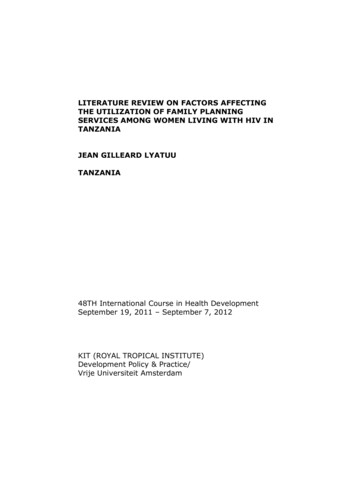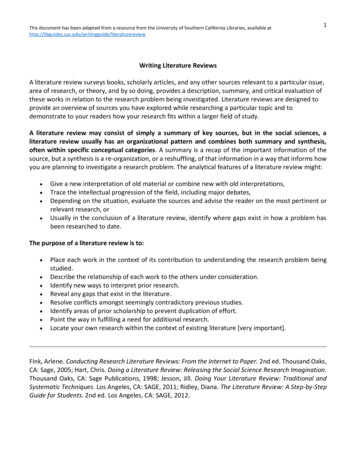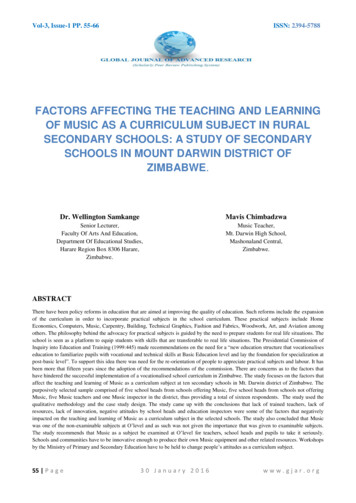
Transcription
LITERATURE REVIEW ON FACTORS AFFECTINGTHE UTILIZATION OF FAMILY PLANNINGSERVICES AMONG WOMEN LIVING WITH HIV INTANZANIAJEAN GILLEARD LYATUUTANZANIA48TH International Course in Health DevelopmentSeptember 19, 2011 – September 7, 2012KIT (ROYAL TROPICAL INSTITUTE)Development Policy & Practice/Vrije Universiteit Amsterdam
A literature review on factors effecting the utilization of familyplanning services Among Women Living With HIV in Tanzania.A thesis submitted in partial fulfilment of the requirement for the degreeon Master of Public HealthByJean Gilleard LyatuuTanzaniaDeclaration:Where other people’s work has been used (either from a printed source,internet or any other source) this has been carefully acknowledged andreferenced in accordance with departmental requirements.The thesis “A literature review on factors effecting the utilization of familyplanning services among women living with HIV in Tanzania”.” is my own work. I have no objection against publishing my thesis onwebsiteSignature 48Th International Course in Health Development (ICHD)September 19, 2011 – September 7, 2012KIT (Royal Tropical Institute)/ Vrije Universiteit AmsterdamAmsterdam, The NetherlandsSeptember 2012Organized by:KIT (Royal Tropical Institute), Development Policy & PracticeAmsterdam, The NetherlandsIn co-operation with:Vrije Universiteit Amsterdam/Free University of Amsterdam (VU)Amsterdam, The Netherlands
Table of ContentsLIST OF FIGURES . IILIST OF TABLES . IIDEDICATION . IIIACKNOWLEDGEMENT . IVDEFINITION OF TERMS . VABBREVIATION . VIABSTRACT .VIIINTRODUCTION. VIIICHAPTER ONE: BACKGROUND INFORMATION . 11.1 TANZANIA PROFILE. 11.2 HEALTH SECTOR . 11.3 HUMAN RESOURCE FOR HEALTH . 31.4 FAMILY PLANNING SITUATION IN TANZANIA . 31.5 HIV IN TANZANIA . 51.6 UNMET NEEDS . 6CHAPTER TWO: PROBLEM DESCRIPTION, OBJECTIVES AND METHODOLOGY . 72.1 PROBLEM DESCRIPTION . 72.2 OBJECTIVES . 82.3 METHODOLOGY -LITERATURE REVIEW . 82.4 CONCEPTUAL FRAMEWORK . 92.5 LIMITATION OF THE STUDY. 11CHAPTER THREE: POLICY RELATED FACTORS-RESULTS . 123.1 NATIONAL HEALTH POLICY . 123.2 RIGHT TO ACCESS AND UTILIZE FAMILY PLANNING SERVICES . 143.3 AVAILABILITY, USE AND APPROPRIATENESS OF FAMILY PLANNING SERVICES GUIDELINE . 153.4 AVAILABILITY OF HUMAN RESOURCE . 153.5 SUMMARY OF POLICY RELATED FACTORS . 16CHAPTER FOUR: SERVICE RELATED FACTORS. 184.1 SKILLS AND ATTITUDE OF HEALTH CARE PROVIDERS . 184.2 AVAILABILITY OF FAMILY PLANNING SUPPLIES . 194.3 ACCESS TO AFFORDABLE FAMILY PLANNING SERVICES FOR HIV POSITIVE WOMEN . 204.4 ACCESS TO QUALITY FAMILY PLANNING SERVICES . 214.5 AVAILABILITY OF USER FRIENDLY SERVICES . 214.6 LINKAGE OF FAMILY PLANNING AND HIV SERVICES . 214.7 SUMMARY OF SERVICES RELATED FACTORS . 22CHAPTER FIVE: CLIENTS RELATED FACTORS . 245.1 KNOWLEDGE ABOUT FAMILY PLANNING AND USE . 245.2 FERTILITY DESIRE . 245.3 EDUCATION LEVEL . 255.4 HIV STATUS . 265.5 SUMMARY OF CLIENT RELATED FACTORS . 26CHAPTER SIX: COMMUNITY RELATED FACTORS . 27i
6.1 MISCONCEPTION AND ACCEPTANCE OF FAMILY PLANNING METHODS . 276.2 RELIGION BELIEFS . 276.3 CULTURAL INFLUENCE, FAMILY AND PARTNER SUPPORT . 286.4 SUMMARY OF COMMUNITY RELATED FACTORS . 28CHAPTER SEVEN: DISCUSSION, CONCLUSION AND RECOMMENDATION . 297.1 POLICY RELATED FACTORS . 297.2 SERVICE RELATED FACTORS . 317.3 CLIENTS AND COMMUNITY RELATED FACTORS . 33REFERENCE . 36ANNEXES . 44ANNEX1: MAP OF TANZANIA . 44ANNEX 2: THE CURRENT CONTRACEPTIVE USE BY AGE . 45ANNEX 3: CONCEPTUAL FRAMEWORK FOR HIV PREVENTION . 46ANNEX 4: CONCEPTUAL FRAMEWORK FOR FERTILITY DESIRE . 47ANNEX 5: CONCEPTUAL FRAMEWORK ON THE UTILIZATION OF FAMILY PLANNING AMONG SEXUALLYACTIVE HIV PEOPLE . 48LIST OF FIGURESFigure 1: Organization of Health Services in Tanzania . 2Figure 2: The percentage of married women using family planning inTanzania from 1991-2010 . 5Figure 3: Adapted Conceptual Framework (Egessa, 2010) . 10Figure 4: Sources of family planning supply verses the use in Tanzania . 19Figure 5: Family planning discussion in HIV care & treatment clinic . 25LIST OF TABLESTable 1: Types of health facilities and ownership . 2Table 2 : Summary of Human Resorce for Health Situation . 16ii
DEDICATIONThis thesis is dedicated to my lovely parents Mr& Mrs Gilleard ReubenLyatuu for their encouragement, spiritual and moral support towards mystudies and life.iii
ACKNOWLEDGEMENTI thank God for giving me His guidance throughout the year and goodhealth. For caring for my parents and others who depend on my support.My sincere gratitude and thanks goes to Netherland Organization forinternational cooperation (NUFFIC) for granting me scholarship to pursuemy Masters studies here in Netherland.My heartfelt goes to the course administration and coordination and thewhole education team in Royal Tropical Institute (KIT) for their supportand guidance towards my studies and knowledge gained which willdevelop my careerMy very special thanks go to my thesis back stopper, whom I haveworked with closely since the initial development to the end.A special word goes to my parents, who kneeling down and call God withall their faith and ask for my success, I should not forget to mention myelder sister Jane, who decide to step on my shoes throughout my absencedespite her being in a Masters course also.Lastly, my classmates ICHD “cohort group” for making the year endpeaceful and joyful with lots of fun and sharing of constructive ideas. I willmiss them.iv
DEFINITION OF TERMSAccessibility of servicesDual protectionFamily planningFamily planning methodsFertility desireMisconceptionModern family planningNatural family planningUtilizationPermanent family planningPrimary levelSecondary levelTertiary levelTraditional family planningUnmet needproximity/ distance to reach theservices areaIs the strategy used to prevent bothunwanted pregnancy and sexualtransmitted infections including HIVwhere there is correct and consistenceuse of condom in conjunction withother contraceptive methodis allowing individual or couples tohave the desired number of childrenthey want and at what interval.are methods used to preventpregnancy or space children or limitthe number of childrenneed/wish for couples or individual toreproducefalse perceptionsHormonal contraceptive methods thatincludes: oral, injectables and barriermethodsMethods includes calendar, rhythm andbreastfeedingUseIncludes surgery (bilateral tubulisationand vasectomy)First level of contact in health careservice can be at the community ordispensary or health centre.Second level of health care servicesDistrict hospitaladvanced/specialised level of healthservicesDiffer with tribesis the discontinuation betweenwomen’s fertility preference and whatshe does to avoid or preventpregnancyv
tal CareAnti-Retroviral TherapyFamily health internationalFamily PlanningHuman Immune VirusHealth Sector ReformHealth Sector Strategic PlanIntra Uterine Contraceptive DeviseLocal Government AuthorityMaternal and Child Health AideMinistry of Health and Social WelfareMedical Store DepartmentMarie Stopes TanzaniaNational AIDS Control ProgramNational Bureau of StatisticsTanzania Demographic Health SurveyNational Health AccountNational Institute for ResearchNational Policy Guideline for Reproductive and Child healthPrevention of Mother To Child TransmissionPoverty Reduction Strategic PlanPopulation Service InternationalReproductive and Child HealthReproductive HealthSub-Sahara AfricaSexual Transmitted InfectionTanzania Commission for AIDSTanzania Baseline SurveyTanzania HIV/AIDS and Malaria Indicator surveyUnited Nation on HIV/AIDSUnited Nations General AssemblyUnited Nations Children’s FundUnited Republic of TanzaniaVoluntary Counselling and TestingWorld Health Organizationvi
ABSTRACTBackground: Despite known advantages of family planning (FP) services,there has been a slow increase in uptake of services in Tanzania. HIVpositive women have limited access to FP services. Governments’ policiesand guidelines have ensured access to free Reproductive Health (RH) andFP services. Several challenges contributed to low uptake of familyplanning services in HIV positive women.Objective: To determine relevant factors affecting the utilization of FPservices among women living with HIV and provide recommendations toimprove the uptake of FP services.Method: Literature review done on utilization of family planning servicesamong HIV positive women in Tanzania and SSA.Findings: A combination of factors contributes to low uptake of FPservices in HIV positive women these includes policy and services deliveryrelated factors studied focused on public, private, private for profitproviders. Unavailability of FP guideline is among challenges observedthat are within government capacity to improve RH services including FPto HIV positive women.Other factors were related to clients and community. Knowledge on FPservices is importance to HIV positive women is a major issue.CONCLUSION: In spite efforts by the government to improve access toFP services, women living with HIV are not targeted. It is important forthe government to replicate efforts of FP implementing partners and rollout FP services to HIV positive women.RECOMMENDATION: The government should reinforce RH policy toensure FP services to HIV positive women and educate community onbenefits of modern FP to HIV positive women.Key words: Utilization; socio-cultural practices; family planning; fertilitydesire; HIVWord count: 11,174vii
INTRODUCTIONAs midwife with clinical and administrative experience, I faced severalchallenges in implementation of RH interventions at different levels ofhealth services. My interest was particularly in HIV reduction strategiesand family planning (FP) implementation. A particular concern from mypersonal experience was the challenges faced by HIV positive women inaccessing FP services.In Tanzania the unmet need for FP is currently at 50% and contraceptiveprevalence is 29 % (NBS, 2010).HIV prevalence in the country is 5.7%and is 9% among pregnant women. This data accounts for the totalpopulation.Globally the prevalence rates of the contraceptives are 63% and Unmetneed for family planning is 11% (WHO, 2010).FP is among 7 components of RH which includes; Safe Motherhood,Family Planning, prevention mother to child transmission, malaria,expanded program of immunization, integrated management of childhoodillness and adolescents. The implementation has been a challenge in thecountry. There is a chronic scarcity of resources in RH with limited fundingand human resources.The FP services are offered free of charge to all women in the countryhowever utilization still remains a challenge.The NBS (2010) reports low utilization of FP services among women aged15-49. Speizer (2007) reported on provider related barriers to accessingFP resulting in low utilization of services in general.Currently there are no studies done to assess access and utilization of FPservices amongst HIV positive women in Tanzania.I would like to conduct a study on factors affecting utilisation of FP useamong HIV positive women.The study is literature review based on literature available and personalexperiences. The results of my study will be shared with the RHdepartment in the Ministry of Health.This paper comprises of seven chapters whereby chapter one providesbackground information of Tanzania including health sector informationrelated to FP use. Chapter two describes the problem, objectives andmethodology. The study findings are explained in three, four, five and ndrecommendations.viii
CHAPTER ONE: BACKGROUND INFORMATION1.1 Tanzania profileUnited Republic of Tanzania is among East African covering approximately94,500 square kilometres. About 60,000 square kilometres of the landsurface is covered by water (includes 5 big lakes). Climatic conditionsinclude two rainfall seasons, March to May ranging from minimum toheavy rains. A long dry period extended from June to October (NBS,2010)Tanzania has an estimated population of 43,187,823 (2012 censusprojection) with a growth rate of 2.4% per year and fertility rate 5.4 perchild birth in a year (NBS, 2010). The life expectancy at birth for maleand female lies between 53/58 years and the under 5 mortality is 108 in1000 live births. Approximately 65% of the population is below the age of25 (MOHSW, 2008b).The country has political stability with an increasing Gross DomesticProduct rate of 6.7% per year. Despite this increase, an estimate of 57%of the population is living under the poverty line of 1 per day (MOF,2011).1.2 Health SectorIn Tanzania, the health sector strategic plans and poverty reductionstrategy are amongst the government’s strategies set to ensuresuccessful implementation of the health policy. These set of free policiesincludes access to maternal health services (UNFPA, 2011).The health system in Tanzania covers the village health post referral up totertiary level. The health system reforms led to decentralization in thechain of service delivery. The reforms included a merger of Ministry ofHealth (MOH) and Ministry of Social Welfare (MOHSW) in 2006.Provision of services is divided into three levels.The primary level comprise of village health posts, dispensaries andhealth centres. The village health posts were identified to serve athousehold level through trained village health workers (VHW) who providebasic FP services.Dispensaries work within the population of 10,000 within 5km radius. Itprovides basic primary health care and supervises the village healthposts.The Health centres works within the population of 50,000 and provide ahigher level of service compared with the dispensary. It has the capacity1
to perform minor procedures including 24hours admission. FP services arealso available.The secondary level contains District Hospital as the first referral. Itserves up to 250,000 populations with specialised medical personnel toprovide back-up surgery, meeting obstetrical emergencies and other lifesaving procedures and referral services. They provide access tocomprehensive family planning. Permanent family planning services(Vasectomy, tubal ligation) are also available.The tertiary level includes the regional hospital and advancedspecialized services. It serves up to 1,000,000 populations. The tertiarylevel of health care is mostly teaching institutions with all advancedtechnology (MOHSW, 2007a). Major medical/ gynaecological conditions,post abortion care, management of infertility are performed.Figure 1: Organization of Health Services in Tanzania(Source: http://www.moh.go.tz, 2006)Delivery of health services is by the public and private sector. Howeverthe public sector through MOHSW covers 60% while the private sectorcovers 30% and private for profit covers 5% of health service delivery(NHA, 2006).Table 1: Types of health facilities and gionalHospitalsOWNERSHIPGOVERNMENT PRIVATE/PARASTATAL FBO1-TOTAL52-721--2121
District55HospitalHealth centre379Dispensaries3324Source: MOHSW 2008b3513619241256585654930The Health Sector Strategic Plan has 5 components of which three amongthe strategies have an impact on increasing utilization of family planningto women living with HIV. These include; health promotion at primarylevel, preventive services and care and treatment at secondary level(MOHSW, 2008c).1.3 Human resource for healthShortages of qualified personnel are among the challenges facing thepublic and private health sector. Inadequate or low number of qualifiedhealth personnel is evident in the rural and hard to reach areas.The contributing factors include geographical location, poor infrastructure,lack or poor staff retention strategies, low output of qualified staff frommedical schools. The human resource demand for medical cadre is at65%. Currently, the doctor-patient’s ratio is 1: 23,000-25,000 and nursepatients’ ratio is 1:6000-10,000 (Msuya et al., 2004).WHO standardsrecommendations for human resource for health are 1 medical doctor per10,000.1.4 Family planning situation in TanzaniaSub-Sahara Africa’s (SSA) current fertility rate is 2.5 (Cahu, 2011).Theuse of modern family planning methods among women of reproductiveage including HIV positive women is low. Women living with humanimmune-deficiency virus (HIV) and acquired immune-deficiency syndrome(AIDS) in SSA constitute 59% of all infected adults.Family planning if used appropriately can prevent one in every threematernal deaths that are likely to occur by allowing women to delaypregnancy, space birth, avoid unintended pregnancies and abortion(Chibwesha et al., 2011). Family planning also contributes to thereduction of vertical transmission of HIV and transmission among couples(WHO, 2011).The unmet need of family planning is still an obstacle on the uptake ofcontraceptive in Sub Saharan African countries. Approximately 25% ofHIV positive women aged15-49 years have unmet need to family planning(UNAIDS, 2012c and Maki, 2012)1. Moreover, there is no data showinguse of family planning services among HIV positive women in SSA(Delvaux et al., 2007)1Definition of unmet need: not desiring pregnancy for the next 6 months and not usingany FP method.3
In Tanzania, the current fertility rate is estimated to be 5.4% (NBS,2010). However, there are service indicators for measuring fertility rateswhich includes; population growth rate (2.9%), contraceptive prevalence(29%) and unmet need for family planning is 50%. This figure does notseparate the unmet need for women living with HIV (NBS, 2010).According to guidelines for FP services, both women and men ofreproductive age group 15-49 years are allowed to decide and use FPservices (MOHSW, 2010).Several studies have been done to assess the trends of family planningservices in the country. MOHSW as the main implementer, contribute to65% on availability of modern contraceptive in public, private and privatefor profit health facilities (NBS, 2010).Types of family planning methods available in Tanzania include; modernand traditional family planning. These methods are provided in primaryand secondary level. The modern family planning methods includes;hormonal and barrier methods for example pills, injections, implanol,condom and Intra Uterine Contraceptive Device (IUCD). Permanent FPmethods available include tubal ligation and vasectomy. Traditional FPmethods (sometimes mixed with natural methods are popular methodspracticed. These methods include; prolonged breastfeeding, rhythm(through vaginal secretion) and calendar (NBS, 2010). There are otherlocal FP methods used depending on different tribes includes; tying apiece of stick around the waist and other herbs (Ernest, 2011).According to NBS (2010), hormonal injectables methods are the mostpopular (11%). Emergency contraceptive methods are also available.Stock out of contraceptives is common in both rural and urban(Fleischman, 2012).Since 1992 there has been an increase in trends of family planningutilization. However, it has stagnated since 2005 (NBS, 2010).4
Figure 2: The percentage of married women using family planningin Tanzania from 1991-2010Source: (NBS, 2010)Family planning services are among four strategies of comprehensivePMTCT. These strategies are aimed at helping women living with HIV toprevent unintended pregnancies, transmission of HIV from mother to child(MTCT), HIV transmission to women of reproductive age and preventionof unintended pregnancies (WHO, 2007;Fleischman, 2012).WHO continues to recommend consistence use of condom and hormonalfamily planning methods as effective prevention of unintended pregnancyand HIV transmission (IRIN, 2012).1.5 HIV in TanzaniaTanzania is among the Sub Saharan African countries with highprevalence of HIV infection. The first case of HIV was identified in 1983 inthe northern part of the country from Uganda. The prevalence of HIV inTanzania has been decreasing from 12.4% in 2005 to 5.7% in 2011. HIVprevalence differs within the country whereby at the northern highlandsHIV prevalence is 15 and the lowest 1% in the islands (THMIS, 2010;TACAIDS, 2012).The important mode of HIV transmission is heterosexual contributing to80% of infected the cases. The HIV prevalence is currently 3.4% forwomen and for men 1.4% (UNGASS, 2012).High risk behaviours contributing to increase HIV transmission in thecountry include; concurrent partnership, early sex initiation, injectingdrug use, increase in mobile and displaced households in mining andfishing areas, men having sex with men and female sex workers(UNGASS, 2010).5
As part of the health sector reforms responding to the HIV epidemic, thegovernment established the national HIV control program (NACP) as thetechnical implementer.More than 85% of the budget for HIV prevention activities is coveredthrough external donor funding.1.6 Unmet needsIn Tanzania, there is 50% of unmet need for family planning to women.However this figure does to separate the unmet need for women livingwith HIV (NBS, 2010). In reference to the study done by Pebody (2011)on contraception and conception found 21% of HIV positive women haveunmet need to family planning. Nine percent (9%) of pregnant womenattending ANC were found to have HIV (UNAIDS, 2009; TACAIDS, 2011)The effectiveness of preventive programs has contributed to the reductionof HIV prevalence from 12% in 2006 to 5.7% in 2011 (UNAIDS, 2009;TACAIDS, 2010). Currently, 93% of health facilities in the country areproviding PMTCT services through reproductive and child health clinics(UNGASS, 2012).The comprehensive HIV prevention strategies include family planninginterventions that are implemented by government and nongovernmental institutions/health facilities based on national HIV policyguide (Mujinja et al., 2009).6
CHAPTER TWO: PROBLEM DESCRIPTION, OBJECTIVES ANDMETHODOLOGY2.1 Problem DescriptionFamily planning services began as a component of maternal and childhealth services in 1989; implemented by the government through thefamily planning association (UMATI). The FP guidelines for service deliverywere developed in 1994. Currently, FP services are provided at primaryand secondary levels. 90% of the population has been reached withfamily planning information (NBS, 2010).The second component of the 5th millennium development goal targetsincreasing FP prevalence to 60%, by 2015 (UNDP, 2011). Tanzania is yetto achieve its expected target for family planning prevalence, despitefamily planning services are available to all when you say all you areincluding HIV-infected women of reproductive age for free. However,there are no family planning services targeted to women living with HIV.According to Kinemo (1997) the reasons for using FP services includefertility control, preventing unintended pregnancies, birth spacing andpreventing STI’s including HIV. The effective use of family planningmethods (as dual protection) to HIV positive women may contribute tothe primary prevention of HIV to the unborn child by 30% (Chibwesha etal., 2011; Duerr et al., 2005)Approximately 760,000 women in Tanzania, are living with HIV/AIDS(UNAIDS, 2010a). Only 38% of women living with HIV reported to havediscussed their fertility desire and family planning issues with health careprovider (Mbatia et al., 2011).No specific study has been done to assess the uptake of family planningservices among HIV positive women. Further, studies show that 50% ofunintended pregnancies among women living with HIV occur as a result oflack of social support and access to family planning services (Duerr et al.,2005; WHO, 2011).A literature review on factors affecting access and utilization of familyplanning services among HIV positive women needs to be explored anddocumented. I would like to investigate relevant factors affecting theaccess and utilization of family planning targeted at HIV positive women,do women living with HIV use FP methods? What are the barriers theyface to access FP services?7
2.2 ObjectivesMain ObjectiveTo explore relevant factors affecting the access and utilization of FPservices among women living with HIV and provide recommendations toimprove the uptake of family planning services.Specific ObjectiveA literature review on factors affecting access and utilization of familyplanning services among HIV positive women needs to be explored anddocumented. I would like to investigate relevant factors affecting theaccess and utilization of family planning targeted at HIV positive women,do women living with HIV use FP methods? What are the barriers theyface to access FP services? To analyse clients related factors and community related factors thataffecting the utilization of family planning among women living withHIV in Tanzania. To identify gaps in and recommend the implementation of familyplanning services to HIV positive women2.3 METHODOLOGY -Literature ReviewThe accomplishment of this thesis is based on the review of literature andstudies done on utilization of family planning among women with HIV inTanzania and other Sub Saharan African countries. The informationgathered includes the family planning situation and related unmet need,family planning and HIV policy and guidelines on implementation ofservices. The stem of information was driven from the report of TanzaniaDemographic Health Survey (TDHS). Other sources were from theNational AIDS control program, Tanzania Commission for AIDS and otherHIV implementing partners.Data was collected from electronic databases published in Englishincluding: Science direct, Google scholar, PubMed, Biomed Central.Review of reports from international organizations and local nongovernmental organization implementing family planning and HIVprograms in Tanzania was done. Government website like MOH, NACP,TACAIDS, and RH were also visited. Gray literature from UN bodies suchas WHO, UNFPA, UNDP, World B
however utilization still remains a challenge. The NBS (2010) reports low utilization of FP services among women aged 15-49. Speizer (2007) reported on provider related barriers to accessing FP resulting in low utilization of services in general. Currently there are no studies done to assess access and utilization of FP










![05[2] Strategy competitors, competitive rivalry .](/img/2/052-strategy-competitors-competitive-rivalry-competitive-behavior-and-competitive-dynamics.jpg)
